Örebro
| Örebro | |
|---|---|
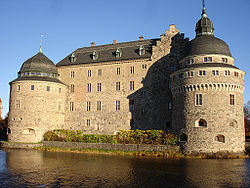 |
|
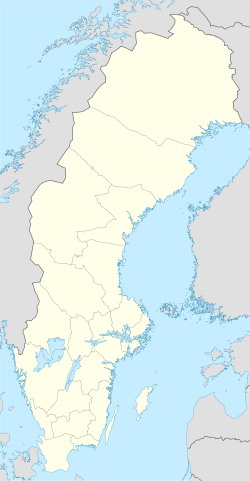 Örebro
|
|
| Coordinates: | |
| Country | Sweden |
| Province | Närke |
| County | Örebro County |
| Municipality | Örebro Municipality |
| Charter | 1404 |
| Area[1] | |
| - Total | 42.96 km2 (16.6 sq mi) |
| Population (2005-12-31)[1] | |
| - Total | 98,237 |
| - Density | 2,287/km2 (5,923.3/sq mi) |
| Time zone | CET (UTC+1) |
| - Summer (DST) | CEST (UTC+2) |
| Website | orebro.se |
Örebro [œrəˈbruː] is a city, the seat of Örebro Municipality and the capital of Örebro County in Sweden with circa 130.000 inhabitants in 2009.[1]
Contents |
History

Örebro received its Royal Charter and city privileges not later than 1404.
Örebro literally means a bridge over gravel banks, which is how the geography looks, with the stream Svartån draining into the lake Hjälmaren. The location became a natural seat of commerce in the (Scandinavian) medieval time, and is mentioned in print in the 13th century. Old buildings from the early days include the foundations of the city church, a building which has undergone several modifications. The natural center of the city is otherwise the magnificent Örebro Castle, situated on an islet in the Svartån, and dividing the town into a northern and a southern part. This castle was constructed during the stewardship of Birger Jarl during the early 13th century and then modified and enlarged during the reign of King Gustav Vasa in the 1560s.
Notable events in Örebro's history include the national diet meeting at Örebro in 1810, where Jean-Baptiste Bernadotte was elected crown prince of Sweden.
Although a trade town, Örebro remained small until the second half of the 19th century, when it grew rapidly as a center of the national shoe manufacturing industry (see: History of Närke).
Geography and climate
| Climate data for Örebro | |||||||||||||
|---|---|---|---|---|---|---|---|---|---|---|---|---|---|
| Month | Jan | Feb | Mar | Apr | May | Jun | Jul | Aug | Sep | Oct | Nov | Dec | Year |
| Average high °C (°F) | 0 (32) |
1 (34) |
5 (41) |
11 (52) |
16 (61) |
20 (68) |
22 (72) |
22 (72) |
17 (63) |
10 (50) |
4 (39) |
0 (32) |
10.7 (51.3) |
| Average low °C (°F) | -4 (25) |
-4 (25) |
-3 (27) |
0 (32) |
5 (41) |
9 (48) |
11 (52) |
11 (52) |
7 (45) |
3 (37) |
0 (32) |
-4 (25) |
2.6 (36.7) |
| Precipitation mm (inches) | 38 (1.5) |
36 (1.42) |
23 (0.91) |
35 (1.38) |
45 (1.77) |
65 (2.56) |
94 (3.7) |
41 (1.61) |
49 (1.93) |
69 (2.72) |
57 (2.24) |
52 (2.05) |
604 (23.78) |
| Source: MSN Weather[2] | |||||||||||||
Sites of interest
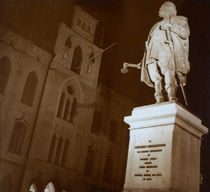
Örebro's old town Wadköping is located on the banks of Svartån (black stream). It contains many 18th and 19th century wooden houses, along with museums and exhibitions. The water tower of Örebro, named Svampen (The Mushroom), is a popular destination as an outlook tower. In 1958, a replica of the tower was built in Riyadh, Saudi Arabia.
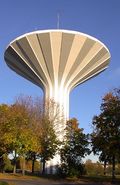
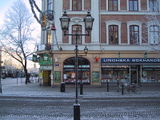
Örebro University is one of Sweden's most recent, being upgraded from högskola (university college) in 1999. It currently has around 14,070 students and a staff of 1,100. Gustavsvik, the largest water park in the Nordic countries, is located just a kilometer south of central Örebro. With more than 700,000 visitors per year, it is one of the most popular tourist and leisure establishments in Sweden. Only Liseberg, Gröna Lund and Skansen are more popular. In the summer the manor of Karlslund is a very popular place to visit.
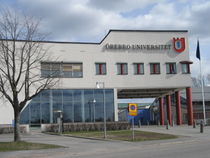


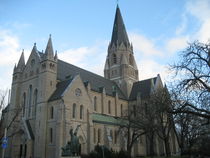
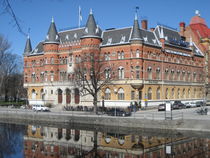
Notable natives
Culture and Media
- Hjalmar Bergman, author
- Fares Fares, actor
- Josef Fares, Film director
- Peter Flack, comedian
- Ernst Kirchsteiger, TV-profile
- Jan-Peter Lahall, photographer, writer
- Edita Morris, author
- Karl Axel Pehrson, artist
- Mary Stävin, former Miss World, actress
- Cajsa Warg, Cookery book author
Music
- Ulla Billquist, Former singer
- Jens Bogren, Producer
- Stephan Berg, Songwriter, winner of Eurovision Song Contest 1991
- Jussi Björling, Former Operatic tenor singer
- Lolita Pop, Former Rock band
- Millencolin, punk rock band
- Nasum, grindcore band
- Path Of No Return, Hardcore Metal band
- Nina Persson, lead singer of the pop group The Cardigans
- Mats Ronander, Rock musician
- Dan Swanö, multi-instrumentalist, lead vocalist of Edge of Sanity
- Witchcraft, doom metal band
- Dead Man, psychadelic rock/folk rock band
- Spetsnaz, EBM electronic band
- Rob Marcello [Guitarplayer]
- Truckfighters, Stoner Rock / Desert Rock band
Politics
- Henry Allard - Speaker of the parliament 1969–1979
- Leni Björklund, Minister of Defence 2002–2006
- Engelbrekt Engelbrektsson, (1390s–1436) rebellious politician and later Sweden's first rikshövitsman
- Erik Agabus Nilsson, Minister of Defence 1917–1920
- Sten Tolgfors, Minister of Defence 2007–
- Daniel Westling, husband of Victoria, Crown Princess of Sweden
Religion
- John Ongman, pastor and founder of the Örebro Missionary Society (today a part of the Evangelical Free Church in Sweden)
- Laurentius Petri, (16th century) Sweden's first Lutheran arch-bishop
- Olaus Petri, (16th century) Principal reformator in Sweden
Science
- Manne Siegbahn, Nobel Prize in Physics laureate
- Gunnar A. Sjögren, Saab designer
- Jonas Wenström, Inventor and engineer
Sports
- Carl Gunnarsson, NHL hockey player
- Peter Andersson, former NHL hockey player
- Christian Berglund, Former NHL hockey player
- Orvar Bergmark, Former Footballer
- Stig Blomqvist, Rally driver.
- Emra Tahirovic, Swedish-Bosnian footballer.
- Hasse Borg, Former Footballer
- Magnus Erlingmark, Former Footballer
- Richard Göransson, Swedish Touring Car driver
- Thomas Nordahl, Former Footballer
- Ronnie Peterson, Former racing driver
- Johan Röjler, ice speed skater
- Timmy (Battousai) Skoog, World-champion of Kyokushin-Karate, and Grand-master of the European Karate-Association.
Sports
Football
- Örebro SK are the most popular football team in Örebro County. The club was founded in 1908 and the team currently play in the highest division in Sweden (Allsvenskan).
- KIF Örebro DFF play in the highest level of women's soccer leagues in Sweden (Damallsvenskan).
- BK Forward currently play in Division 1 Norra.
- Karlslunds IF currently play in Division 2 Södra Svealand.
- Rynninge IK currently play in Division 3 Västra Svealand.
- Adolfsbergs IK currently play in Division 3 Västra Svealand.
- Örebro Syrianska BK currently play in Division 3 Västra Svealand.
Volleyball
- Örebro Volley play in the highest level of women's volleyball leagues in Sweden. They have won the league ten times.
Ice Hockey
- Örebro Hockey Vipers currently play in Allsvenskan(the second level) in the Swedish Hockey League.
American Football
- Örebro Black Knights are an American Football Club that played in the Swedish Championship Finals in 1998 and 1999.
Rugby
Floorball
- Örebro SK Innebandy
- Lillån IBK
- Axbergs IF
- Nerike IBK
Culture
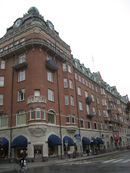
- Swedish Chamber Orchestra
- Örebro is the hometown of the punk-rock band Millencolin. They named one of their albums Pennybridge Pioneers, where Pennybridge stands for Örebro as a colloquial translation into English.
- The influential and highly popular grind band Nasum were formed in Örebro.
- Örebro is one of the public broadcaster SVT's 12 local news districts and has television permises located in the city.
International relations
Twin towns - Sister cities
 Łódź in Poland (since 2001) [4]
Łódź in Poland (since 2001) [4]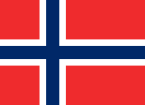 Drammen in Norway
Drammen in Norway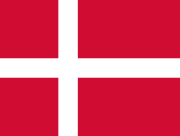 Kolding in Denmark
Kolding in Denmark 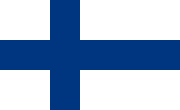 Lappeenranta in Finland
Lappeenranta in Finland 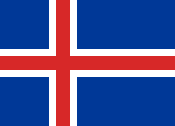 Stykkisholmur in Iceland
Stykkisholmur in Iceland  Yantai in China
Yantai in China 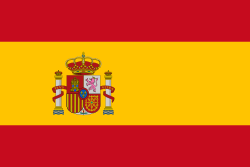 Terrassa in Spain
Terrassa in Spain  Pau in France
Pau in France
See also
- Örebro Municipality
- Nerikes Allehanda
- Julmust
References
- ↑ 1.0 1.1 1.2 "Tätorternas landareal, folkmängd och invånare per km2 2000 och 2005" (in Swedish) (xls). Statistics Sweden. http://www.scb.se/statistik/MI/MI0810/2005A01B/T%c3%a4torternami0810tab1.xls. Retrieved 2009-05-10.
- ↑ "Weather Information for Örebro". World Weather Information Service. http://weather.msn.com/local.aspx?wealocations=wc:24557&q=%c3%96rebro%2c+SWE. Retrieved 1 January 2009.
- ↑ Vänorter - http://www.orebro.se/2444.html:
- ↑ "Twin Cities". The City of Łódź Office.
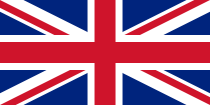
 (in English and Polish) © 2007 UMŁ. http://en.www.uml.lodz.pl/index.php?str=2029. Retrieved 2008-10-23.
(in English and Polish) © 2007 UMŁ. http://en.www.uml.lodz.pl/index.php?str=2029. Retrieved 2008-10-23.
External links
- Örebro - Official site
| Örebro is one of 133 places with the historical city status in Sweden. |
|
|||||
|
||||||||||||||
|
|||||||||
|
|||||||||||||||||||||||||||||||||||||||||||||||||||||||||||||||||||
|
|||||||||||||||||||||||||||||||||||||||||||||||||||||||||||||||||||||||||||||||||||||||||||||||||||||||